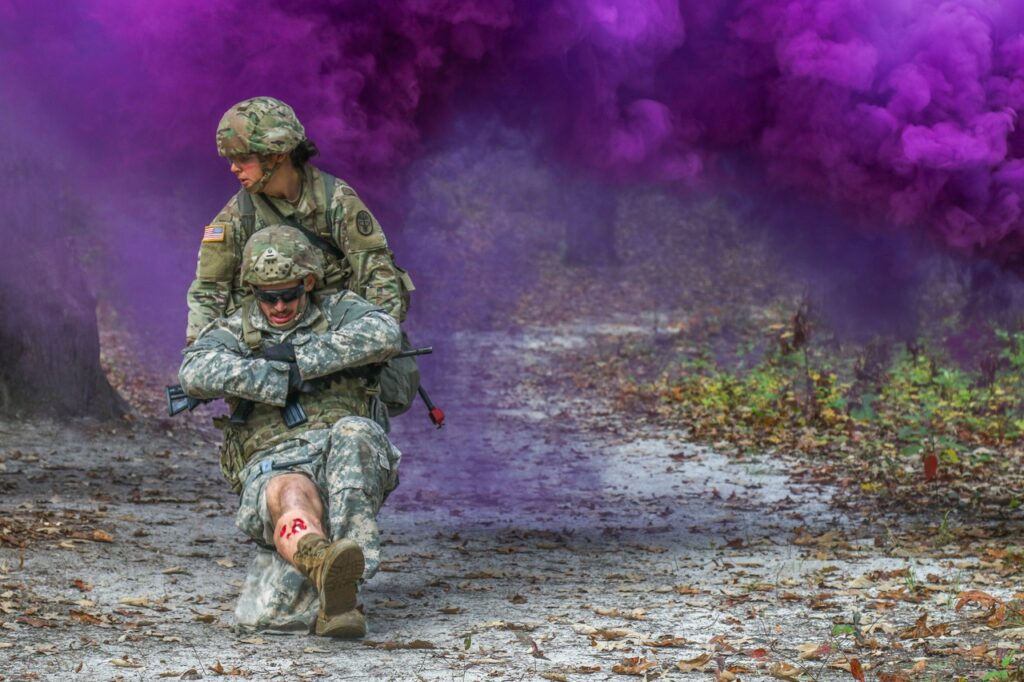
The F-22 Raptor: America’s “Aerial Quarterback”
Here’s What You Need to Know: Citing budget concerns, Air Force officials have said it is unlikely the service will build new F-22s.
As a fifth-generation stealth fighter, the F-22 is specifically engineered for air supremacy and air dominance missions, meaning its radar-evading technology is designed to elude and destroy enemy air defenses. The aircraft is also configured to function as the world’s premier air-to-air fighter able to “dogfight” and readily destroy enemy aircraft.
“Air superiority, using stealth characteristics is our primary role. The air dominance mission is what we will always do first. Once we are comfortable operating in that battlespace, our airmen are going to find ways to contribute,” Col. Larry Broadwell, the Commander of the 1st Operations Group at Joint Base Langley-Eustis, Virginia, told Scout Warrior in a special pilot interview.
The F-22’s command and control sensors and avionics help other coalition aircraft identify and destroy targets. While some of the aircraft’s technologies are not “publically discussable,” Broadwell did say that the F-22’s active and passive sensors allow it to function as an “aerial quarterback” allowing the mission to unfold.
For example, drawing upon information from a ground-based command and control center or nearby surveillance plane – such as a Joint Surveillance and Target Attack Radar System – the F-22 can receive information or target coordinates from nearby drones, Broadwell explained.
At the moment, targeting information from drones is relayed from the ground station back up to an F-22. However, computer algorithms and technology is fast evolving such that aircraft like an F-22s will soon be able to quickly view drone video feeds in the cockpit without needing a ground station — and eventually be able to control nearby drones from the air. These developments were highlighted in a special Scout Warrior interview with Air Force Chief Scientist Greg Zacharias.
Zacharias explained that fifth generation fighters such as the F-35 and F-22 are quickly approaching an ability to command-and-control nearby drones from the air. This would allow unmanned systems to deliver payload, test enemy air defenses and potentially extend the reach of ISR misisons.
“Because of its sensors, the F-22 is uniquely able to improve the battlefield awareness – not just for airborne F-22s but the other platforms that are airborne as well,” he said. The Raptor has an F-22-specific data link to share information with other F-22s and also has the ability to use a known data link called LINK 16 which enables it to communicate with other aircraft in the coalition, Broadwell explained in an interview last year.
Newer F-22s have a technology called Synthetic Aperture Radar, or SAR, which uses electromagnetic signals or “pings” to deliver a picture or rendering of the terrain below, allow for better target identification.
The SAR technology sends a ping to the ground and then analyzes the return signal to calculate the contours, distance and characteristics of the ground below.
“The addition of SAR mapping has certainly enhanced our air-to-ground capability. Previously, we would have to take off with pre-determined target coordinates. Now, we have an ability to more dynamically use the SAR to pinpoint a target while airborne,” Broadwell added.
“The F-35 is needed because it is to global precision attack what the F-22 is to air superiority,” he added. “These two aircrafts were built to work together in concert. It is unfortunate that we have so few F-22s. We are going to ask the F-35 to contribute to the air superiority mission,” he said.
Overall, the Air Force operates somewhere between 80 and 100 F-22s. Dave Majumdar, defense editor here at TNI, writes that many would like to see more F-22s added to the Air Force arsenal. For instance, some members of Congress, such as Rep. Randy Forbes, R-Va., have requested that more F-22s be built, given its technological superiority.
Citing budget concerns, Air Force officials have said it is unlikely the service will want to build new F-22s, however an incoming Trump administration could possibly want to change that.
F-22 Technologies:
The F-22 is known for a range of technologies including an ability called “super cruise” which enables the fighter to reach speeds of Mach 1.5 without needing to turn on its after burners.
“The F-22 engines produce more thrust than any current fighter engine. The combination of sleek aerodynamic design and increased thrust allows the F-22 to cruise at supersonic airspeeds. Super Cruise greatly expands the F-22’s operating envelope in both speed and range over current fighters, which must use fuel-consuming afterburner to operate at supersonic speeds,” Broadwell explained.
The fighter jet fires a 20mm cannon and has the ability to carry and fire all the air-to-air and air-to-ground weapons including precision-guided ground bombs, such Joint Direct Attack Munitions called the GBU 32 and GBU 39, Broadwell explained. In the air-to-air configuration the Raptor carries six AIM-120 AMRAAMs and two AIM-9 Sidewinders, he added.
“The F-22 possesses a sophisticated sensor suite allowing the pilot to track, identify, shoot and kill air-to-air threats before being detected. Significant advances in cockpit design and sensor fusion improve the pilot’s situational awareness,” he said.
It also uses what’s called a radar-warning receiver – a technology which uses an updateable data base called “mission data files” to recognize a wide-range of enemy fighters, Broadwell said.
Made by Lockheed Martin and Boeing, the F-22 uses two Pratt & Whitney F119-PW-100 turbofan engines with afterburners and two-dimensional thrust vectoring nozzles, an Air Force statement said. It is 16-feet tall, 62-feet long and weighs 43,340 pounds. Its maximum take-off weight is 83,500.
The aircraft was first introduced in December of 2005, and each plane costs $143 million, Air Force statements say.
“Its greatest asset is the ability to target attack and kill an enemy without the enemy ever being aware they are there,” Broadwell added.
The Air Force’s stealthy F-22 Raptor fighter jet delivered some of the first strikes in the U.S.-led attacks on the Islamic State in Iraq and Syria, when aerial bombing began in 2014, service officials told Scout Warrior.
After delivering some of the first strikes in the U.S. Coalition-led military action against ISIS, the F-22 began to shift its focus from an air-dominance mission to one more focused on supporting attacks on the ground.
“An F-22 squadron led the first strike in OIR (Operation Inherent Resolve). The aircraft made historic contributions in the air-to-ground regime,”
Even though ISIS does not have sophisticated air defenses or fighter jets of their own to challenge the F-22, there are still impactful ways in which the F-22 continues to greatly help the ongoing attacks, Broadwell said.
“There are no issues with the air superiority mission. That is the first thing they focus on. After that, they can transition to what they have been doing over the last several months and that has been figuring out innovative ways to contribute in the air-to-ground regime to support the coalition,” Broadwell said.
Kris Osborn became the Managing Editor of Scout Warrior in August of 2015. His role with Scout.com includes managing content on the Scout Warrior site and generating independently sourced original material. Scout Warrior is aimed at providing engaging, substantial military-specific content covering a range of key areas such as weapons, emerging or next-generation technologies and issues of relevance to the military. Just prior to coming to Scout Warrior, Osborn served as an Associate Editor at the Military.com. Osborn previously served at the Pentagon as a Highly Qualified Expert with the Office of the Assistant Secretary of the Army – Acquisition, Logistics & Technology. Osborn has also worked as an anchor and on-air military specialist at CNN and CNN Headline News. This story originally appeared in Scout Warrior.
This article first appeared in November 2016.
Image: U.S. Air Force photo by Scott Knuteson


